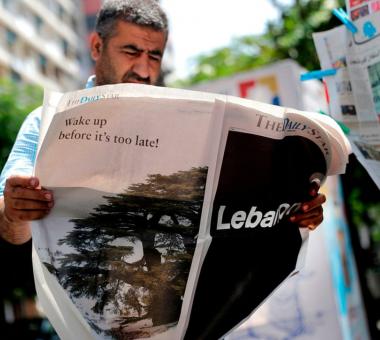How Deep Is the Lebanese Financial Crisis Now?
The Lebanese economy has been suffering from a set of complex crises that - through interaction - became evident by the end of 2019, at what time a dramatic collapse started, affecting various aspects of public life. What are the most prominent manifestations of these crises?
by STRATEGIECS Team
- Publisher – STRATEGIECS
- Release Date – Jan 12, 2021

A new wave of popular protest began in Lebanon in October 2019 against the deteriorating living conditions and the failure to seek any solutions to the worsening economic conditions in the foreseeable future. It turned out that this new wave was never like any preceding one; as it continued, albeit frequently, with different momentum, form and organization. It has repercussions not only in the street, but also in various public spaces, such as the media, social networks, and even official discourse as well. Indeed, it is all logical enough, but what indicates that this scene will not come to a close, at least in the near future, is that Lebanon suffers from a deep financial crisis rooted in the country's economic history and intertwined with political reality for the time being.
Since the financial crisis in Lebanon is the main trigger for the emergence of incessant protests, we must understand the causes and implications of this crisis, or at least recognize its general manifestation.
The Lebanese balance of payments, i.e., the money flowing into and out of Lebanon, has been characterized by a deficit since 2011, reaching 16.1 billion dollars between 2011 and 2018. Later on, the deficit dramatically declined, recording $ 10 billion by the end of the third quarter of 2020, according to data from the Central Bank and the Association of Banks in Lebanon.
This means that the dollar assets at local banks and the Bank of Lebanon are very low, which entitles the country only to pay for the import of basic needs (wheat, fuel, medicine, etc.) at the official exchange rate fixed at 1507.5 L.P. per dollar, making these commodities "subsidized", but not for a long time.
In early March 2020, the then Prime Minister, Hassan Diab, announced that the government was unable to pay the 1.2 billion dollars owed to Eurobonds holders, an unprecedented decision in the country's history through which it has paved the way for rescheduling debts. For their part, the Lebanese banks, which hold a large percentage of these Eurobonds, consider that default will worsen the situation regarding the size of hard currency liquidity in economic life.
The public debt constitutes 170% of the Lebanese GDP, estimated at $ 94.8 billion by the end of September 2020, 30 billion of which is in Eurobonds.
Here we must point out a very important part, which is that Lebanese banks used to own Eurobonds - which were supposed to be paid on March 9, 2020 - worth $ 900 billion compared to $ 300 billion in favor of foreign companies and banks. However, the case was different couple of weeks before the payment is due, as the latter now owns $ 720 billion against $ 480 billion. It means that some Lebanese banks sold half of their Eurobonds in order to avoid the cost of rescheduling, noting that the sale involved a loss. This case required the intervention of the judiciary, because the sale of Eurobonds took place abroad, meaning that hard currency did not flow into the country at a time when small depositors were withdrawing a maximum of $ 100 per week from local banks, in order to implement the so-called "liquidity management".
After defaulting, which can be considered an indirect or timid declaration of bankruptcy, Lebanon's credit rating has fallen to the selective default (SD), which is the lowest level on the scale of S&P ratings. This means that the Lebanese state, in addition to its dollar liquidity crisis, is facing a solvency crisis that blocked the way to obtaining foreign financing due to the loss of confidence in the Lebanese financial sector in international markets.
In the context of the Lebanese indebtedness, in April 2020 there was official talk about proposals to contain the financial crisis within the framework of an economic reform plan that included demands to write off part of the debt and recover the money that was transferred abroad. However, this plan did not see the light, and some believe that the Lebanese state's writing off part of the debt is illogical in principle, due to the nature of this internal debt in its vast majority (43% for the Banque du Liban, 44% for commercial banks). Deleting part of it would further complicate the dollar liquidity crisis; in other words, the solution to delaying or canceling payment will exacerbate the liquidity shortage crisis, not to mention the loss of the remaining confidence in the Lebanese financial sector, given that the Banque du Liban and commercial banks employ deposits for Lebanese and non-Lebanese in the lending.
At another level, late April 2020 witnessed a rapid deterioration of the Lebanese pound, reaching 3900-4200 L.P. per dollar, the matter which sparked the discontent of the popular circles that took to the streets despite the official limitations of the covid-19 pandemic. In response to that and in parallel with it, BDL has issued circular no. 148, which includes the possibility of small depositors to withdraw their dollar deposits, but in Lebanese pounds, within the framework of the "market rate" as described by the circular, which turned out to be less than the real exchange rate. What made the situation worse was the issuance of another circular no. 551, which stipulated that the values of remittances from abroad in hard currency be exchanged in Lebanese pounds against the "market rate", which was again found to be less than the current exchange rate.
These measures, which are supposed to be remedial, mean in one way or another that there will be a need to print more local currency, thus resulting in higher inflation and lower exchange rate of the Lebanese pound.
Currently, the exchange rate of the Lebanese pound exceeds 8000 L.P. per US dollar. In the end, it became clear that the peg to the US dollar gave the Lebanese pound a power that it did not possess, which ultimately led to its collapse in front of the requirements of paying its debts in hard currency and financing the current account.
The crisis, unprecedented since the Lebanese Civil War, resulted, according to some observers, from the structural nature of the economic model based on remittances from expatriates to provide hard currency, in addition to the reliance of banking on state lending and support for real estate activity, which is ultimately non-productive. Thus, we are not talking here about a developmental situation based on productive sectors entering the economic cycle to recreate themselves through the financial investments, but rather about unsecured cash supply chains that are affected to a large extent by the degree of political and economic stability in the region and the world.
Covid-19, Caesar Act, and Beirut Explosion
Given that the economic impact of the outbreak of the Covid-19 has been disastrous not only on the economies of developed countries, but also on economies that can be classified as minimally stable, its impact on an economy that is going through a deep crisis like the Lebanese economy can be catastrophic. Government estimates expect the GDP to fall by 12%, as 50% of the population have become under poverty line, unemployment rates exceeded 30%, inflation reached critical figures, recording 89.7% during June 2020, and thus commodity prices doubled in conjunction with the decrease in the purchasing power.
Of course, sect-based political quota system increases the narrowness and the slow pace of finding a solution to the existing crisis. Examples include, but arenot limited to, the Capital Control that would regulate the movement of funds to and from Lebanon has not been approved until this moment. Also, understandings with the International Monetary Fund that could have resulted in $ 10 billion during the past three years have faltered, noting that the Lebanese economy needs 30 billion dollars to be saved, according to the former Minister of Interior, Ziad Baroud, in an interview with Independent Arabia in June 2020.
In the same context, the Minister of Finance, Ghazi Al-Wazni, announced, in November 2020, that the criminal audit of the BDL's accounts that the company "Alvarez and Marsal" was assigned to by the government had failed due to a dispute between the Prime Minister of Lebanon at the time, Hassan Diab, and the governor of the BDL Riad Salameh, on the discrepancy in figures regarding deficits and financial losses, a discrepancy that appeared during the series of meetings with the IMF delegation that came to Beirut in May 2020.
What aggravated the situation is that the Caesar Act entered into force in June 2020, imposing sanctions on the Syrian regime, including personalities, institutions and those with whom international or local economic partners deal. Consequently, the repercussions of this law began to appear on the Lebanese economy due to the connection of certain sectors with their Syrian counterparts, and the tragic incident of the Beirut port explosion followed, which left tens of deaths and tens of billions of material losses.
Currently, the possibility of floating the Lebanese pound is being studied. This step, if carried out in an ill-considered manner, could lead to a major food crisis due to its connection with the issue of lifting and rationalizing subsidies. Therefore, this is another issue that is added to a number of issues that resulted and dealt with the economic crisis in Lebanon, in light of political polarization and an ongoing power vacuum.
There is no doubt that the exit from the economic crisis or the agreement on a clear recovery plan must pass through the gate of political consensus. However, it is clear that this will not happen during the first quarter of 2021; given that, after the port explosion, the formation of a new government with French support is still stagnant.
All evidence indicates that the economic and political system that ruled in Lebanon during the 28 years that followed the Taif Agreement has lost its effectiveness and exhausted the means and options for its existence. This leads us to the fact that maintaining such model will be through coercive means, the consequences of which cannot be predicted.

STRATEGIECS Team
Policy Analysis Team
 العربية
العربية